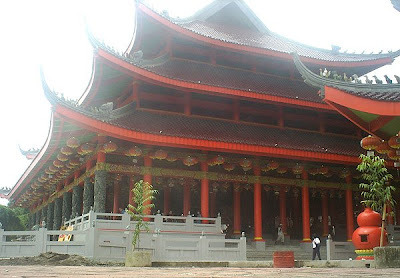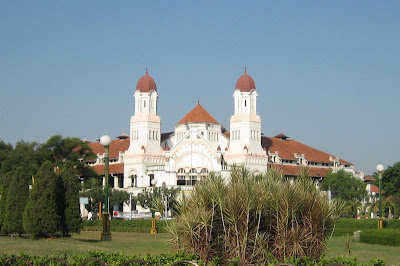The city weather is hot and humid. Wear cotton clothes. You do not need long sleeves shirt, instead a T-shirt and knee-long trousers are comfortable. Some places like mosques (masjid) and temples require polite dress such as long trousers/skirts. Hot pants/mini skirts will attract people attention and might be considered impolite.
Semarang is off the tourist trail and knowing even basic Indonesian will be helpful (and courteous), although younger people can often speak some English.
Tourism Information Centre TIC:
- Jalan Madukoro Blok BB. Tel.: (62)(24) 7608570.
- Jalan Pemuda 147. Tel.: (62)(24) 3515451. Next to Novotel Hotel.
By plane: Semarang's Airport is Ahmad Yani International Airport, quite nearby from the city centre. Daily flights are available to many major cities in Indonesia. Garuda Indonesia, Merpati Nusantara, Mandala Air, Adam Air, Batavia Air, Sriwijaya Air and Jatayu Airlines fly to Jakarta daily. Merpati also has daily flight to Surabaya. Deraya flies to Pangkalanbun and Bandung. There is also flight service to Yogyakarta by Trigana Air/Kalstar. Trigana Air/Kalstar and Indonesia Air Transport also fly daily to Pankalanbun. The airport's only international flight is to Singapore four times a week by Garuda Indonesia.
By train: Semarang is connected to Jakarta, Bandung and Surabaya by trains. Interestingly, there is no comparable railway service to Yogyakarta, although a railway line exists. The Argo Muria express connects Semarang to Jakarta, and with its relatively new equipment (2002), is very comfortable. The downside is the very early departure (5.00 AM!) to Jakarta. Overnight trains are also available. The fastest train between Semarang and Jakarta takes around 6 hours. Bandung and Surabaya are also connected to Semarang with air-conditioned eksekutif class trains.
There are two main railway station in Semarang, Stasiun Tawang and Stasiun Poncol. On the northern main line, between Semarang and Pekalongan, the railway line follows the coast line, providing passengers with beautiful views of the Java Sea.
By car: Semarang can be reached by car from Jakarta. It takes around 10 to 12 hours depending on the road traffic. You can choose to leave early in the morning from Jakarta to arrive in Semarang the next 12 hours. Over night drive is faster yet more challenging and even dangerous for "Pantura" non familiar driver. Pantura derives from "Pantai" which means Beach and "Utara" which means North.
You will pass small towns like Patrol, Jatibarang, and relatively bigger ones like Cirebon. Before entering Cirebon, you can take the toll road instead of taking into Cirebon traffic if you do not want to drop by in Cirebon. After exit from the Cirebon toll road, you will drive eastward along Losari and then you will pass Tegal, Pemalang, Pekalongan and Kendal before you arrive in Semarang.
Gas station are abundant, you can see them almost every 5 or 10 kilometers along the road. They have toilet facilities. Pay Rp1,000 (US$ 10 cents). Beware of small or old gas station, they have poor lighting and terrible toilet. Choose a newer and bigger gas station with good lighting parking space and clean toilets. Please make sure that you have locked your car and do not leave your valuable unattended.
By bus: Many bus services from Jakarta to Semarang. You can choose to go in the day time with air conditioned (A/C) from Pasar Rebo Bus Terminal in East Jakarta, Kalideres Bus Terminal in West Jakarta or from Lebak Bulus Bus Terminal in South Jakarta. The overnight bus with A/C are also available with good services. You can choose bus operators such as: "Rosalia Indah", "Kramat Jati", "Raya", "Safari Dharma Raya" as the good reputed bus serving Jakarta to Semarang. Sometimes the bus route is Jakarta to Solo via Semarang, you can choose them too, but please remind the bus driver's assistant (usually male, a person who check your ticket onboard the bus) to wake you up in Semarang.
There is also the executive-class tourist bus Joglosemar, that connects Jogjakarta, Solo and Semarang (hence the name). Joglosemar picks up tourists from specific hotels and provide snacks and water for your trip. Considerably pricier than other executive buses, it is more comfortable and provides a friendly service throughout the journey.
By boat: Jakarta - Semarang (vice versa) traditionally travelled via railway, northern coast road ("pantura") or by plane. A trip by a sea vessel is uncommon due to its rare schedule and length of journey that takes too long compared with train (approx 6 hours) and over night bus (9 hours).
Tourist Destinations:

- Tanjung Mas. A busy, important port during Dutch occupation (from 17th century to 1945).

- Gunung Ungaran with its tea and jasmine plantation, Gua Kreo / Kreo Cave with its interesting stalactite and stalagmite and of course Marina at Tanjung Mas are the alternatives for those who has more than 2 free days in Semarang.

- Museum Ronggowarsito, Jln. Abdurrahman Saleh No. 1, Phone: +62-24-7602389, 8AM-2PM, except on Monday. Javanese culture and art. Rp2.000 (Mar 2008).
- Marina Beach. North Semarang. Facility: swimming pool, children playground, beach volley ball, water sports.
- Mangkang Zoo, located in the West Semarang. There a lot of animal preserve there but it lacks of attraction.
Source: Wikitravel

 The Famous Ampera Bridge
The Famous Ampera Bridge





 Ganesha, God of Knowledge, son of Shiva
Ganesha, God of Knowledge, son of Shiva